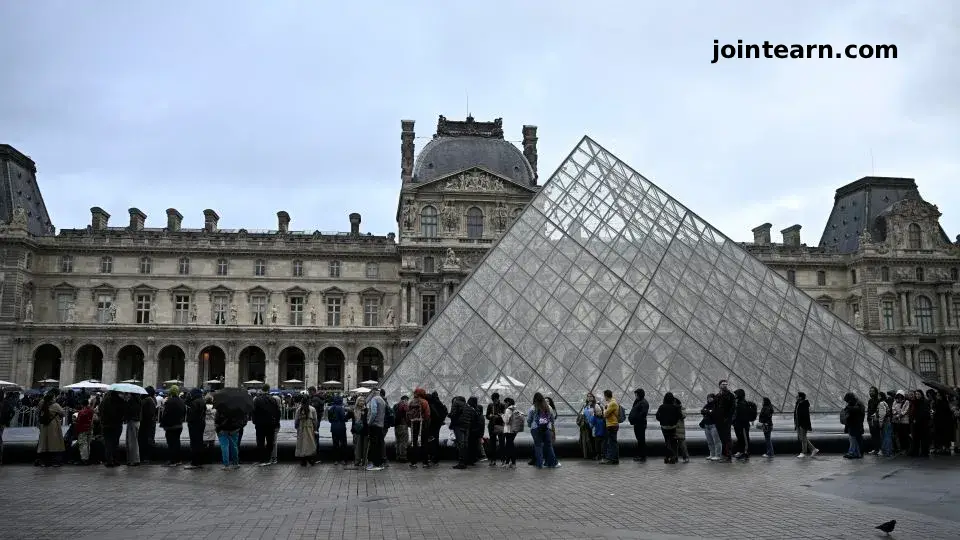
Spectacular Louvre Robbery Shakes Paris
Paris, France — French authorities are scrambling to recover priceless royal jewels stolen in a daring daylight heist at the Louvre Museum, with the loot valued at €88 million ($102 million). The jewelry, part of France’s historic crown collection from the Napoleonic era, was taken from the museum’s famed Apollo Gallery on Sunday morning.
Paris Prosecutor Laure Beccuau confirmed that the stolen artifacts include pieces once worn by Queen Marie-Amélie and Queen Hortense, calling the robbery both an economic and cultural tragedy.
“The value of the loss is spectacular, but the historical damage is beyond measure,” Beccuau told RTL Radio.
How the Heist Unfolded
Investigators say the Louvre robbery was meticulously executed, lasting just seven minutes.
At 9:34 a.m., two men disguised in yellow safety vests used a truck-mounted ladder to climb through a window into the Apollo Gallery. Armed with an angle grinder and a blowtorch, they smashed two reinforced glass display cases, seizing the jewels before escaping on two scooters along the Seine River.
“By 9:38 a.m., they were gone,” said Beccuau. “It was a lightning-fast, highly professional operation.”
Authorities later found the getaway truck abandoned and are combing it for DNA evidence and fingerprints. One of the scooters and a helmet believed to belong to one of the robbers have also been recovered.
What Was Stolen: Priceless French Crown Jewels
The stolen treasures include:
- A diamond and sapphire tiara and necklace once worn by Queen Marie-Amélie and Queen Hortense.
- A Napoleonic emerald jewelry set — a wedding gift from Emperor Napoleon Bonaparte to Marie-Louise of Austria in 1810 — containing 32 emeralds and 1,138 diamonds.
Eight of the nine pieces taken remain missing, raising fears that the jewels have already been smuggled out of France.
A Blow to French Heritage and National Pride
French Justice Minister Gérald Darmanin called the heist a “failure of museum security”, noting that key vulnerabilities — such as unsecured windows and public access to the truck route — made the operation possible.
“The French people all feel like they’ve been robbed,” Darmanin said.
Author Elaine Sciolino, who has written extensively on the Louvre, described the theft as “a dagger into the heart of French history.”
The Louvre, originally a royal fortress turned museum, remains closed until further notice, though most exhibits will reopen Wednesday. The Apollo Gallery, however, will stay sealed as forensic teams continue their investigation.
Organized Crime and International Concerns
Investigators suspect the theft was orchestrated by an international crime network, given its sophistication and precision.
French Senator Natalie Goulet expressed skepticism that the jewels will ever be recovered.
“They’ve probably already been taken abroad,” she told CNN. “The jewelry will be cut up, melted down, or sold on the black market. It’s a classic method of money laundering.”
Art recovery experts agree. Christopher Marinello, founder of Art Recovery International, warned that once historic pieces are dismantled, their cultural value is lost forever.
“If these gangs are not stopped, we’ll keep losing treasures we can never see again,” Marinello said.
A Troubling Pattern of Museum Heists in Europe
The Louvre robbery joins a long list of major European museum thefts:
- 1911: Leonardo da Vinci’s Mona Lisa was stolen from the Louvre by handyman Vincenzo Peruggia, taking two years to recover.
- 1998: A painting by Camille Corot vanished from the Louvre and remains missing.
- 2024: Robbers blew open the Drents Museum in the Netherlands, stealing four ancient gold artifacts, including the Helmet of Cotofenesti, a 5th-century BC relic.
These repeated heists highlight vulnerabilities in even the world’s most secure institutions.
Investigation Continues Amid Fading Hope
Over 100 French investigators are now on the case, analyzing surveillance footage and coordinating with Interpol and Europol. Authorities have built a forensic tent around the recovered truck to fume it for fingerprints, but progress has been slow.
While the public remains hopeful, experts admit that time is running out.
“The longer the jewels remain missing, the smaller the chance we have of ever recovering them intact,” Beccuau warned.
As France reels from the audacious theft, the Louvre heist serves as both a national scandal and a wake-up call about protecting the world’s most treasured artifacts.


Leave a Reply